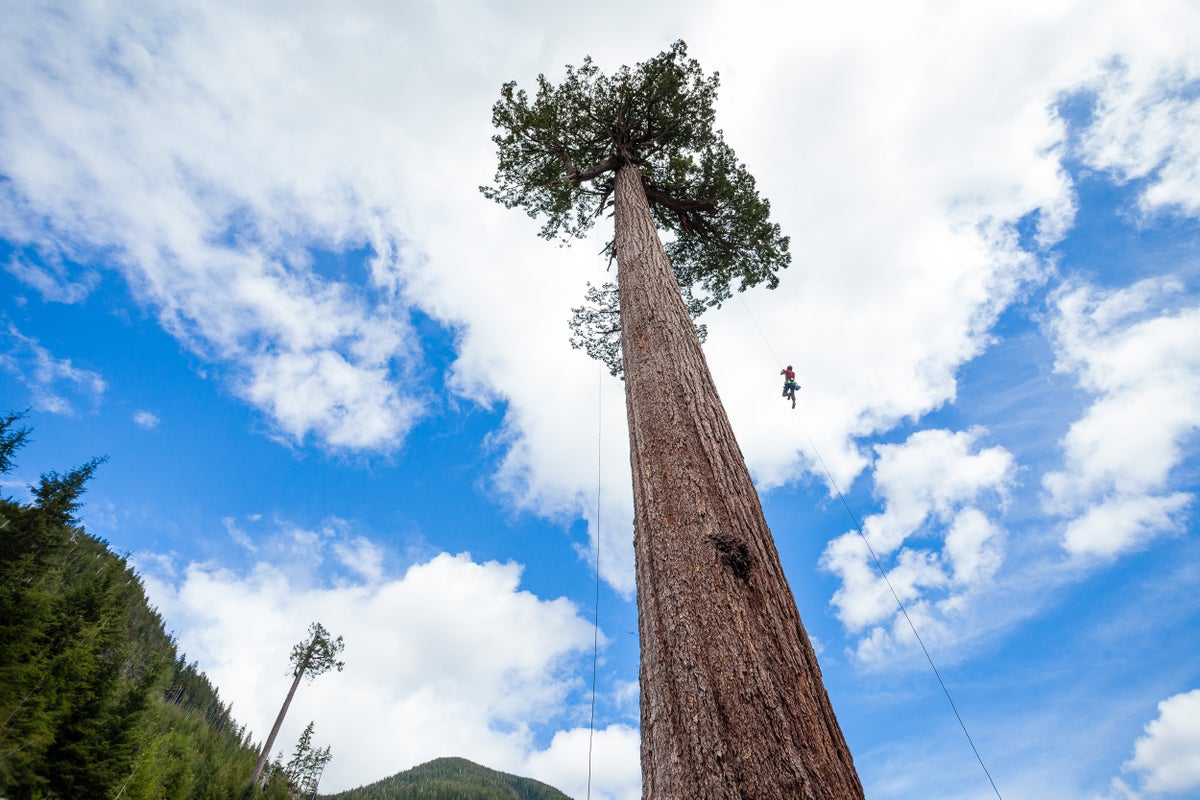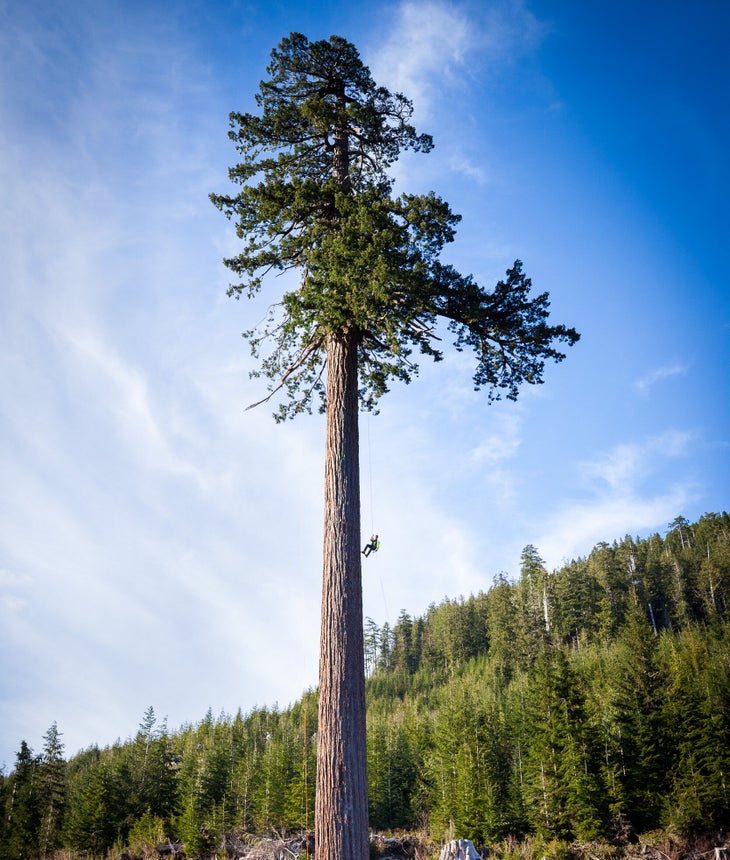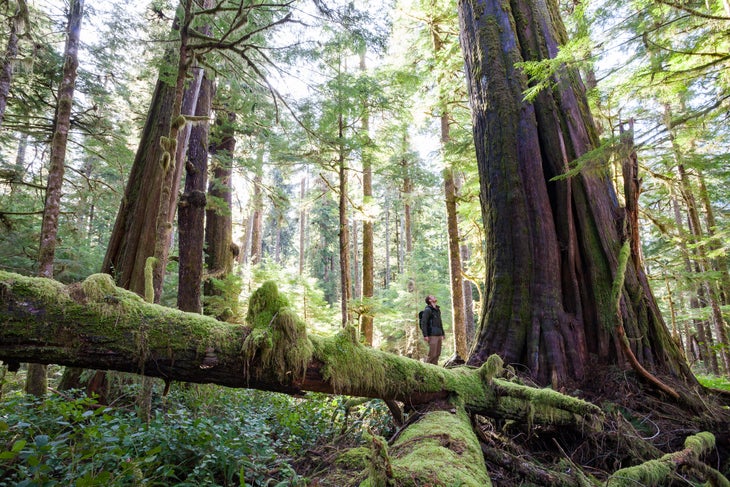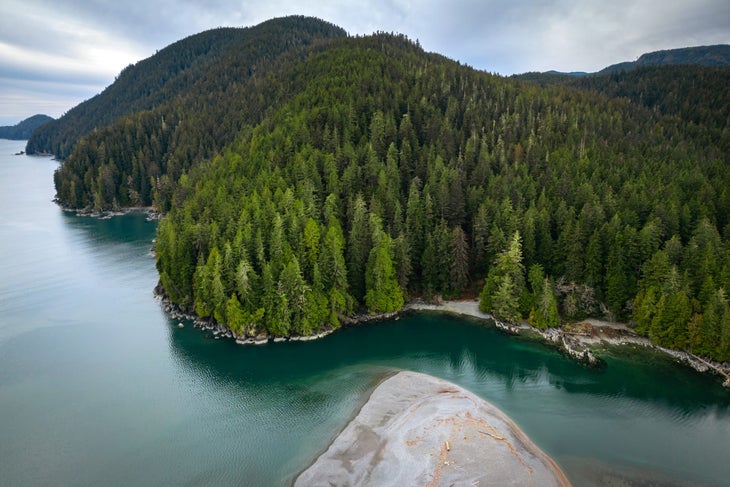
Big Lonely Doug is a sight to behold—achingly beautiful yet incredibly sad. The thousand-year-old, two-hundred-foot Douglas Fir stands in the midst of a vast clear-cut on the rugged west coast of Vancouver Island, a towering beanstalk surrounded by acres of cornfield stubble. It was spared from saw blades just over a decade ago by a logger who inexplicably tied flagging tape around it with the words “Leave Tree.” The tree was discovered by photographer and activist TJ Watt just days after the area had been cleared.
“It was just shocking to see,” says Watt, who gave Big Lonely Doug its nickname. “When you’re in the forest, it’s hard to truly grasp how big these giants really are. But when you see a lonely tree like that, it’s like a living skyscraper.”
Since then, Big Lonely Doug has taken on a very different life—now serving as a tourist attraction. Every summer, tree lovers (“dendrophiles”) and Instagrammers flock to the nearby town of Port Renfrew, the self-proclaimed Tall Tree Capital of Canada, and then navigate a maze of logging roads, all to snap a pic and gaze up at Big Lonely Doug.
Maybe more than anything, though, they come to feel a sense of awe. It’s what drew me to this remote place as well—the chance to see some of British Columbia’s last remaining old-growth trees, before it’s too late.

Welcome to the Tall Tree Capital, Port Renfrew
Big Lonely Doug might be the most famous big tree in the Port Renfrew area, but it’s not the only arboreal attraction. Within a forty-five minute drive of the tiny outpost (official population: 262), visitors can find the Red Cedar Fir, believed to be the biggest Douglas Fir in the world, the Harris Creek Sitka Spruce, the third largest of its kind, and a stand of trees known as Avatar Grove, which features dozens of moss-draped, centuries-old trees that loggers somehow overlooked.
Unlike old-growth forests elsewhere in the province, which often require hours of slogging down muddy, root-laced trails, the big trees around Renfrew are relatively easy to get to, even for non-hikers. “There is an incredible amount of interest and desire to see old-growth in a wilderness setting, but for most people it has to be accessible,” says Watt, who has led much of the trail building in the area, including raised boardwalks in Avatar Grove.
That these exceptionally big, long-lived trees are all within a short drive of Renfrew is due largely to the area’s unique climate. The town itself gets a whopping one-hundred-and-forty inches of rain a year on average—more than triple that of Seattle—with mild temperatures all year round. That soggy, temperate weather is ideal for plant growth and minimizes the risk of forest fires: a perfect recipe for producing big, old trees.
There’s some irony to all of this, of course. The area has long been home to the Pacheedaht (“People of the Sea Foam”) First Nation, who regard cedar trees as sacred. But for much of the past two centuries, Port Renfrew’s main source of employment was not promoting trees but rather chopping them down—particularly, giant, old-growth trees that fetched the highest value. For much of that time, it was a lucrative business— until it wasn’t.

In the 1990s, protesters blockaded logging roads in Clayoquot Sound about a hundred miles north of Port Renfrew, making international headlines for what was dubbed the “War in the Woods.” More recently, more than a thousand people were arrested in a similar stand-off at Fairy Creek just east of Renfrew, making it the biggest act of civil disobedience in Canadian history.
With the logging industry facing stiff economic challenges and more public scrutiny than ever, it’s left some small communities in B.C. looking for other ways to generate jobs and economic growth. Eco-tourism is often cited as an option. But Port Renfrew might be the first to market the trees themselves.
Set in a fjord flanked by coastal mountains, the town has long drawn sport fishermen and hikers aiming to do the multi-day West Coast Trail or Juan de Fuca Trail. Starting about a decade ago, the local chamber of commerce, with help from Watt and other volunteers, began promoting the town as the Tall Tree Capital, as a way to diversify itself.
There was some resistance in the community early on, admits Watt. Renfrew was built on logging, after all, and it’s still a big employer in the region. But it didn’t take long for residents to see the potential benefits of eco-tourism. “People got on board pretty quickly when they saw the major uptick in their businesses and people staying in the hotels and eating at the café,” Watt says. “Money talks.”

The economic impact of big tree tourism is hard to quantify, says Ian Laing, co-owner of the Wild Renfrew Resort as well as the local pub. But where much of logging revenue goes to head offices and sawmills elsewhere, tree tourism is helping create jobs in town. “It creates more Airbnbs, for example,” says Laing, “which results in more landscapers, more housekeepers, more places to eat. It results in a bigger market.”
There are obvious signs of a modest tourism boom: new cabins and yurts popping up, a recently opened sauna, and a cold plunge spa. At the cozy Coastal Café, visitors can buy kitschy t-shirts and postcards emblazoned with cartoons of the area’s most well-known trees. A local writer’s retreat—co-founded by Harley Rustad, author of the acclaimed non-fiction book about Big Lonely Doug—offers a popular wilderness writing week every spring.
Follow the Big Tree Trail
“We’re seeing thousands of people coming, and a big portion of that is for the trees,” says Laing. “The farther we get away from logging and more into ecotourism, like what a beautiful thing.”
Seeing giant trees is clearly the draw, but searching for them can be half the fun—a bit like a treasure hunt. A few years ago, the Port Renfrew Chamber of Commerce and the non-profit Ancient Forest Alliance, co-founded by Watt, created a big tree map to help. Some of the more well-known trees are easy to spot—the two-hundred-and-sixty-foot Harris Creek Spruce, for example, is easily visible from a paved, well-travelled road. Others, though, take a bit more effort.

With the big tree map in hand, I set out to find a lesser-known clutch of old-growth called Jurassic Grove. I drove south from Renfrew along the coast, looking for a telephone pole with a metal stamp marked, simply, 217. After some back and forth, I eventually found the pole and, beside it—as described on the map—an unmarked trail that dipped into the forest.
I hiked through a second-growth forest, in full treasure-hunter mode now, rushing past Devil’s Club and sword ferns. Ten minutes in, I reached the first big tree: a massive Western Red Cedar, its trunk wide enough to drive a pick-up truck through. I kept going, following bits of fluorescent pink flagging tape. Soon, I reached the grove itself: a dozen or so majestic old-growth conifers, standing like monuments and shrouded in mist that was drifting in from the Pacific. I paused, took a deep breath, and gazed upwards. This was it: the moment of awe, the reason I had come all this way.
The post See a ‘Living Skyscraper’ in the Tall Tree Capital of Port Renfrew appeared first on Outside Online.














